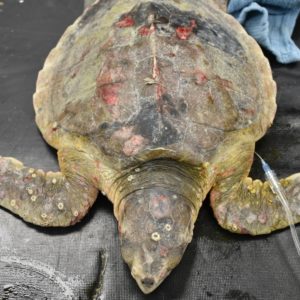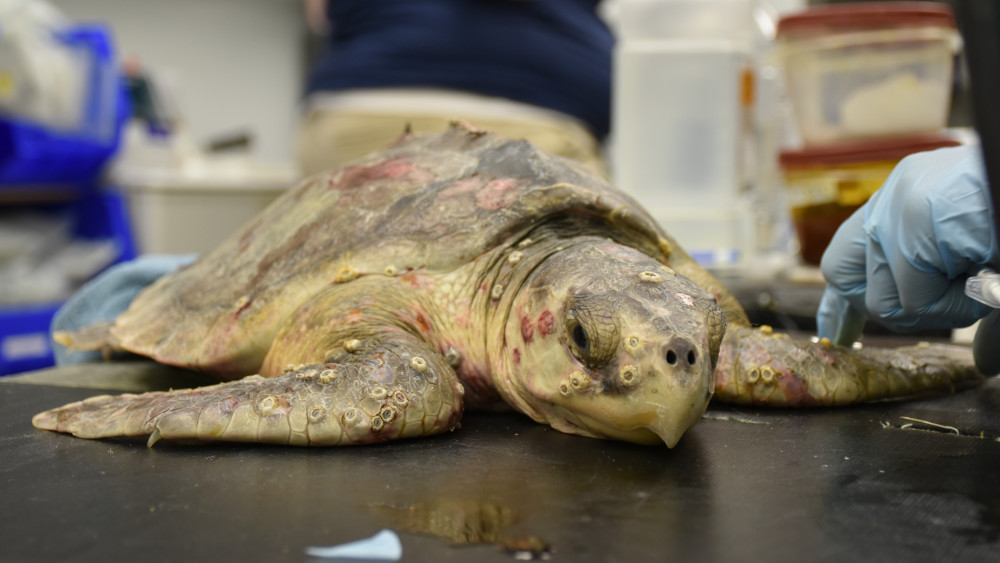Kemp’s Ridley (Lepidochelys kempii)
Stranding Location: Charleston Harbor shipping channel, SC
Arrival Date: April 18, 2016
Age: Juvenile
Weight: 2.73 kg (6 lbs.)
Case History
This juvenile Kemp’s ridley sea turtle was pulled into one of the largest suction hopper dredges in the nation, the Glenn Edwards. The dredge operation is taking place just 3 to 5 miles off South Carolina’s coast to deepen the shipping channel into the Charleston Harbor. This little turtle is very lucky to be alive, and it is nothing short of a miracle that s/he was able to make it through the dredge’s powerful suction pipe with only a few abrasions and lacerations. Fortunately, SCDNR Sea Turtle Coordinator, Michelle Pate, and Army Corps of Engineers Biologist, Matt Messensmith, were working on the ship when they found this endangered juvenile Kemp’s ridley. Their job as marine observers is to record the number of turtle fatalities and injuries caused by the dredge, and to facilitate the reduction of sea turtles being negatively impacted. One of the observation vessels at the dredge site was even able to transport the turtle straight to the docks adjacent to the South Carolina Aquarium for medical treatment.

Treatment
Hospital staff was quick to treat this young turtle once s/he arrived at the aquarium on Monday afternoon. It was apparent that after all this turtle had been through, that s/he was very fortunate to be alive. Stabilization treatments included administering SQ (under the skin) fluids, vitamins, antibiotics, and pain medication, as well as taking radiographs, and processing blood. It was evident that this turtle was healthy, in good body condition. It was evident from the presence of a crab claw visible on radiographs, that Hopper had been actively foraging prior to getting caught in the dredge. There were numerous abrasions to the soft tissue and shell that were treated topically with Silver Collasate (a wound healing product that works wonders in turtles), as well as a fracture of the plastron. Later that day, the turtle, which is now being called Hopper after the type of dredge, was placed down in the hospital in a full tank of low salinity water. Internal damage is still a point of concern but it is clear that this turtle is a fighter. Prognosis is fair.
Updates
20 April 2016: We are pleased to report that Hopper is swimming around and already eating! S/he seems to have normal buoyancy control and swimming abilities. Today, Hopper was offered smelt at 0.5% BW, which was energetically consumed without a fuss. We will slowly increase the salinity of the tank and will continue with antibiotics and routine radiographs.
25 May 2016: Hopper is one energetic turtle and is commonly observed zipping around the tank. S/he’s abrasions are healing nicely, with the exception of one of the neck abrasions. This wound is taking longer to heal and will need to be debrided/cleaned by the veterinarian next week.
18 June 2016: Hopper has definitely earned his/her name as s/he is always hopping around and never seems to stop moving! Almost all of the wounds sustained from the hopper dredge have since healed and the neck abscess is closing up up nicely. Hopper recently went offsite to receive a CT scan which revealed some trauma to the lungs. We will continue to monitor this with repeat radiographs but most likely the trauma will not require treatment. Overall, this is one healthy, active turtle who should be released this summer.
Release Date
July 15, 2016
Release Location
Folly Beach County Park


